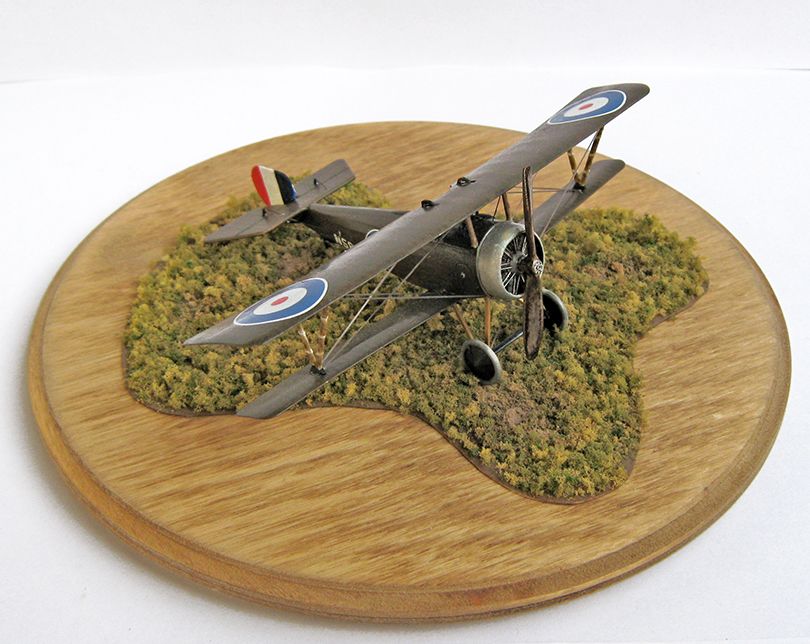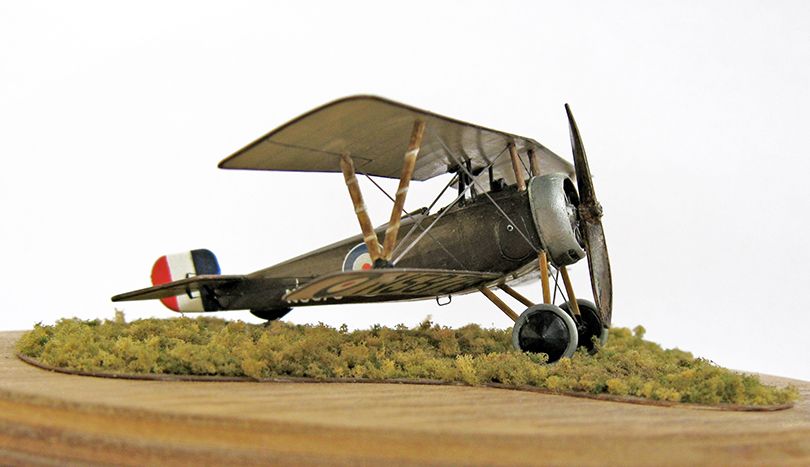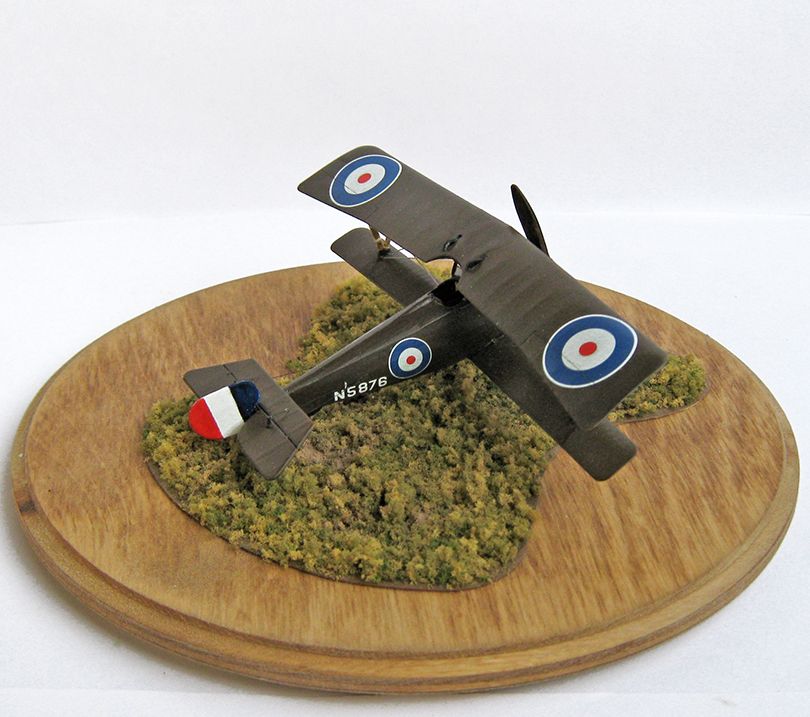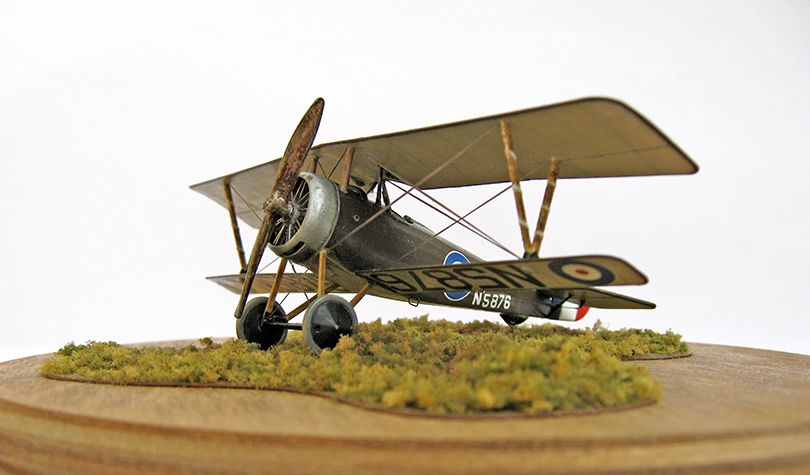
We who have an interest in the early history of aviation often enjoy pointing out that just about every feature of the modern air power age may be seen foreshadowed in the aerial activities of the Great War. A contract for fifty Nieuport 17
bis scouts let to the newly formed Nieuport and General Aircraft Company by England's Admiralty in 1916 may serve to illustrate in a small way that mis-directed effort and waste of money in procurement of military aircraft, often complained of today, is one more thing that can be seen foreshadowed in the aerial activities of the Great War.
The Nieuport 17
bis was the first attempt by Nieuport's designer, Gustav Delage, to meet the competition of the rising star of the French
Aviation Militaire, the S.P.A.D. VII. The S.P.A.D., coming into service in the summer of 1916, was faster and much more strongly built than Nieuport's 'V' strut sesquiplanes, though not nearly so maneuverable. There was not much could be done about the structural limitations of the 'V' strut design, but to increase speed, Delage replaced the 110hp LeRhone rotary motor of the standard N-17 with a 130hp Clerget, and streamlined its fuselage by fairing out its sides to a rounded section with a light structure of stringers.

An early example of the N-17
bis was given to a premier French air fighter, Sub-Lt. Nussenger, who thought highly of it, but the type was not taken on by the
Aviation Militaire. England's Royal Naval Air Service, however, had ordered thirty of the type from the Nieuport firm at Paris by early November, 1916.

A good deal of muddle came to attend this order.
The R.N.A.S. had also given a contract for 50 N-17
bis machines to the newly formed Nieuport & General Aircraft Company, established that same November at Cricklewood, London, by Samuel Waring, a leading furniture manufacturer. As that trade required some facility with wood-work, it was a natural fit with constructing aeroplanes, and the market for aeroplanes was expanding rapidly while that for furniture was certainly not.
The first N-17
bis delivered from Nieuport at Paris to the R.N.A.S. was to be a pattern for the new company's licensed production of the type. The Nieuport firm at Paris came to believe, mistakenly, that the Admiralty meant all production of the N-17
bis for the R.N.A.S. was to be undertaken in England, a course the firm opposed strenuously. In consequence, the first N-17
bis was not delivered to the R.N.A.S. from Nieuport at Paris until January, 1917. Further delay was imposed by difficulties attending the delivery of sufficient Clerget motors to Nieuport. The Nieuport & General Aircraft Co. in England did not receive its pattern machine till the end of February. Not only the inexperience of the new firm, but again a scarcity of engines, hampered the start of production at Cricklewood.
It was not until late in April, 1917, that the first four N-17
bis built in England reached No. 6 Naval squadron in France, and by then, the type had proved a considerable disappointment. No. 6 Naval, equipped since March with French-built N-17
bis machines, found them slower and less handy than expected, and difficult to land into the bargain. This doubtless owed in part to their being equipped with two machine guns, a synchronized Vickers and a Lewis mounted atop the upper wing's center-section, which, taken together with their ammunition supply, constituted a heavy load indeed. The unit had taken heavy casualties and had few successes. The R.N.A.S. decided in May the N-17
bis should be replaced in No. 6 Naval by the new Sopwith Camel, and this was done during June.

Nonetheless, the production line finally gotten started by the Nieuport & General Aircraft Co. at Cricklewood continued to deliver on its contract. The firm sent examples of the N-17
bis on for acceptance at Hendon through the summer. Once assembled out of their crates there, the aeroplanes were sent on to various Naval air and training stations, where they were used for gunnery and other advanced training, and sometimes considered 'defense' machines for the station. One is recorded as having taken off from Eastchurch in a futile attempt to engage Gotha bombers that August. By October, the machines still being delivered were going straight into storage, without instruments fitted, and sometimes with 110 hp Clerget motors, or no motor at all; this was the disposition of 26 out of the 50 produced. Perhaps the final indignity was the taking of several out of store for delivery to Handley-Page, to be used in training young women hired to work on building Handley-Page bombers, though it is hard to imagine assembling and disassembling the little Nieuports was good practice for working on the big twin-engined machines that company produced.

Delivery of the fifty machines from the Nieuport & General Aircraft Co. to the R.N.A.S. must have cost close to a hundred thousand pounds sterling: the motors cost nearly a thousand, the airframe probably about six hundred, and the cost of guns and synchronizing equipment would have been a separate item that could not have been inconsiderable. To put it in better perspective than any attempt to translate this into terms of modern money, consider that a skilled tradesman in the building industry, a carpenter or a mason, would have expected a year's income of about a hundred pounds sterling in 1917. The most that can be said for the expenditure is that it got the firm on its feet as a contractor, subsequently building several hundred Sopwith Camels and Snipes. The firm gave a brief billet to Mr. Folland, designer of the S.E. 5/5a, when the Royal Aircraft Factory was dissolved, and while there he designed the Nighthawk fighter. When the Nieuport & General shut down in 1920, he and the Nighthawk moved on to the Gloster Aircraft Company.
The attempt by Delage to improve the 'V' strut Nieuport design was to proceed during 1917 along the lines sketched in by the N-17
bis. An improved LeRhone developing 120hp was substituted for the Clerget, a redesigned upper wing and new, lower-drag tail surfaces would be added to the rounded fuselage. But the result would prove inferior to the S.P.A.D., and quite failed to restore the sesquiplane design to its earlier primacy. It was the S.P.A.D. which became the predominant fighting type in the
Aviation Militaire in the last half of the Great War, and Nieuport abandoned the 'V' strut pattern entirely in its designs of 1918.

This particular machine, N5876, was one of the last few N-17
bis built by the Nieuport & General which were put into service, rather than going directly into storage. It was delivered to Hendon early in August, assembled there, and assigned to R.N.A.S. Chingford as a 'defensive aircraft' towards the end of the month. It arrived too late to have met any use against the Gothas, which shifted to night operations in September. It remained an ornament of that basic training facility, where pupils received their introduction to flight on old Maurice Farman 'shorthorns', taking off from and landing on "a strip of fogbound and soggy meadowland . . . between a reservoir (The King George reservoir) and a sewage farm". When the Royal Air Force was formed in April, 1918, N5876 was transfered to Old Sarum, becoming part of the equipment of No. 11 Training Depot. Past this its career has gone unrecorded, but it is unlikely to have lasted past the Armistice in any case. Chingford field disappeared under water when London's reservoir system was expanded in 1935.

This model in 1/72 scale is put together using the wings of an Eduard N-17 kit, and the fuselage of a Roden N-24
bis kit. They blend together surprisingly well. Cowling is from the Eduard kit, with some re-working; motor, tail, and wheels come from the Roden kit, and the Roden Clerget rotary is a little gem. It proved necessary to scratch-build the undercarriage legs and the aileron cranks. The non-standard presentation of the serial number is shown on a photograph of the machine at Old Sarum; it can be taken as an indication that at the very least the machine had its fabric renewed some time after it was delivered by the Nieuport & General, and that it may well have had a bad pranging which necessitated extensive repair at some point in its career.
Details of the build can be found here:
http://forum.ww1aircraftmodels.com/index.php?topic=4896.0.